“Frenzied”: The first Scottish renewables boom, hydroelectric 1940-1970
The story of a remarkable construction boom that kept the lights on during the 1966 World Cup final. Also includes ‘fish lifts’, zonal pricing of renewables in Scotland, the origins of ‘Treasury Brain
Origins
The story of electricity in Britain began with a flirtation with renewable generation. In 1881 Godalming in Surrey became the first town in the world to use electric street lighting following the expiration of its gas contract. The power was generated from a waterfall on the river Wey. Unfortunately, it was a false start. The scheme wasn’t profitable and was shut down in 1884. Gas lighting was restored. In 1882 came the first pilot of the ‘Edison system’ at Holborn Viaduct in London. It involved the world’s first coal fired power station. From that point on the ‘black gold’ of coal reigned supreme for just over a century.
Figure 1: The town of Godalming illuminated by electric lighting, 1881.
In other countries with less abundant coal the ‘white gold’ of hydroelectric generation fared much better. In the 1890s technological advances in the form of high voltage transmission lines and transformers reduced the cost and complexity of transporting electricity over long distances. The first demonstration of point-to-point transmission was the Lauffen-to-Frankfurt line in 1891 in Germany. In a marvellous case of showmanship, a hydroelectric generation station in Lauffen powered a man-made waterfall at an exhibition in Frankfurt. Over the 1890s hydro power grew rapidly in the USA, especially in California, as well as in the Nordics and central Europe. In the USA the Niagara Falls system was developed in 1895. Spain built a 250 KM transmission line into Madrid in 1909, setting a new a European record for the longest power line.
Geography determined whether a region was well placed to develop hydroelectricity. The simplest type was a ‘run-of-the-river’ facility, with water channelled through a canal or penstock to spin a turbine. Britain simply didn’t have as many suitable sites for ‘run-of-the-river’ hydro as the USA or continental Europe. A crucial factor in determining the attractiveness of a site was the water available and the vertical distance, or ‘the head’, through which the water could be made to fall to reach a turbine. Damming could help improve the potential of a location, but it was costly and disruptive. Much like offshore wind today, hydro was expensive to build but once constructed was (in theory) less costly than coal fired generation. In the Nordics and the USA hydro contributed to driving down the price of electricity, which led to an increase in electricity consumption especially in manufacturing.
In Britain the Grampian Supply Company, the largest in the North of Scotland, made some advances and constructed the first major hydroelectric scheme at Rannoch between 1927 and 1930. However, this was an isolated success distant from population centres and without network infrastructure to transport the power to other areas. In 1926 the Conservative prime minister Stanley Baldwin set up the Central Electricity Board (CEB) to address the overarching backwardness of the British electricity industry, a result of excessive fragmentation. The centrepiece of the CEB’s plan was to build a new ‘National Grid’ to interconnect the different regions of Britain and select the most efficient power stations to supply ‘bulk power’. The new 132KV National Grid only spread as far as Central Scotland but never extended into the Highlands (see Figure 2). A single transmission line owned by the Grampian Company extended up to Rannoch.
Figure 2: The power stations selected by the CEB and 132KV National Grid Network in Central and Southern Scotland, as of 1936.
Source; Bloomfield, British Electrical History, The South East Scotland Electricity Board Area (here)
Another issue was that landowners, aristocrats and the coal industry successfully lobbied against hydro. In 1936 parliament rejected a proposal by the Caledonia Power Company to develop hydro in the region. In 1941 a proposal to develop Glen Affric was defeated on amenity grounds.
By the beginning of the Second World War, Britain lagged a long way behind other countries in hydroelectricity. In 1938 only 5% of electricity supply came from hydro, the lowest of any European country. In contrast Norway generated 95% of its electricity from hydro and per capita electricity consumption was 4.8x higher.
Founding the North of Scotland Hydroelectric Board (NSHEB)
The appointment of Tom Johnston as Secretary of State for Scotland in 1941 marked a turning point for hydro. Johnston joined other Labour politicians in Winston Churchill’s cross-party war ministry. Between the 1910s and 1930s Johnston had been part of a radical socialist grouping in Glasgow known as the ‘Red Clydesiders’. He was also active in Glasgow’s Friendly Society movement (a form of cooperative sickness and medical insurance). In the 1930s he developed the concept of an ‘all-in’ insurance scheme covering unemployment, pensions and health. This idea would be influential in the development of the Welfare State under the post-war Labour government of Clement Attlee. Johnston was also committed to alleviating unemployment and reducing migration from the Highlands. He became convinced that developing hydroelectricity was a means to achieve both ends, inspired by Franklin D Roosevelt’s state-owned Tennessee Valley Authority project. There was a precedence. At Foyers, on the east shore of Loch Ness, the British Aluminium Company had built a hydro scheme in 1896 to supply its factory with power. The massive smelting works was 10% of the entire world’s smelting capacity at the time.
In 1943 Parliament passed the Hydro Electric Development Act and the North of Scotland Hydro Electric Board (NSHEB) was established. It had two objectives: to develop hydroelectric power and electrify the remote parts of the Highlands. This made the Board was one of the earliest expressions of the link between public ownership of natural resources and distributing the benefits of electricity to all citizens. Profit from the sale of surplus electricity to England would be ploughed back into distributing power to the more remote, low-populated areas of the Highlands for ‘the economic development and social improvement of the region’. Johnston appointed Edward MacColl as Deputy Chairman, an electrical engineer who had tried and failed to develop a hydro scheme at Loch Sloy. MacColl built a team of engineers fascinated by the engineering challenge and imbued with a sense that they were engaged in a great act of national renewal.
Only five years later there were even more dramatic changes. In 1947 the Electricity Act brought the entire industry under state ownership. The British Electrical Authority (BEA) controlled all generation and transmission, and Fourteen Area Boards were responsible for all distribution and retail. Between 1945 to 1947 there were fierce debates between Johnston as Secretary of State for Scotland and Walter Citrine, the new Chair of the British Electrical Authority, over the ongoing relationship between the BEA and NSHEB. Johnston feared being subsumed into the new Westminster based organisation and campaigned aggressively for almost total autonomy.
The matter was settled in a story that speaks to a simpler time: when politicians were more decisive, and the energy industry wasn’t blighted by ‘consultations’. In 1947 Emmanuel Shinwell, the Minister for Fuel and Power in Attlee’s government, travelled up to Scotland to meet Johnston. The two old friends and ‘Red Clydesiders’ met at the site of one of the massive hydro schemes being developed at Pitlochry. Shinwell informed all advisers and civil servants to wait as the two men went for a walk. No official heard a word of their conversation. After a short time, they returned and Shinwell announced, ‘I’ve decided the Board will retain its autonomy’. The NSHEB was unique among the Area Boards, with complete control over generation, transmission, distribution and retail in a territory covering 21,750 square miles and a population of 1.1 million. Critically, the NSHEB reported into the Secretary of State for Scotland and not the Minister for Fuel and Power.
Over the next several years Scottish energy autonomy only grew stronger. After their election in 1951 the Conservatives introduced an even more decentralised structure for the electricity industry, creating two Scottish boards that operated independently. Like NSHEB, the South of Scotland Board, created in 1955, also had total control over generation, transmission, distribution and retail. The Scottish boards viewed the regime to the South with contempt. Johnston rarely attended the British Electrical Authority meetings and even when the committee arranged to meet in Edinburgh Johnston missed the meeting on the grounds he was in London that day.
‘Frenzied’
The Scottish hydro programme between 1945 and 1960 was of a similar scale and pace to the other energy mega projects of the post-war years – the nuclear programmes, the Supergrid, oil-to-gas processing, the first LNG shipments, gas conversion, the building of the gas transmission system.
Between 1944 and 1947 twelve schemes were approved, plus another 320 miles of 132KV grid, as compared to the ~3000 miles that existed already to the South. Getting going proved challenging. The first major project at Loch Sloy was a massive 130 MW capacity scheme. After a protracted public enquiry in Edinburgh in 1944 construction began in 1945. Then the project faced major delays due to acute shortage of steel, cement, equipment, timber and labour. Hiring was especially challenging. The hydro projects were gruelling work, with engineers facing torrential rain, snow and wind. There was an extremely high casualty rate, with injuries and deaths on almost all projects.
There were many objections to the hydro developments on grounds of the impact on the landscape, grouse shooting and fishing. The Board was very conscious of the importance of salmon fishing to the Highlands and went to extraordinary lengths to protect the fish. ‘Fish lifts’ were included in the design of many of the dams. Salmon were attracted by water flow into a chamber, a sluice gate was closed, and water was allowed to rise in the tunnel until reaching the higher reservoir. Clunie, Pitlochry and Orrin were all fitted with substantial fish passes. Figure 3 gives a sense of the scale of the additional features at Orrin. (Apologies for the those who find this trivial, I am trying to appeal to those that think modern Britain cannot build infrastructure because of an overly accommodating attitude to fish).
Figure 3; The ‘Fish Lift’ at Orrin; the fish pass is the sloping concrete structure in the centre.
Another issue was how to pay for the projects. The engineers that worked under Edward MacColl in the mid-1940s didn’t develop any detailed costings. The overall economics of hydro seemed like a no brainer at the time; interest rates were low, and coal prices were high. Doing detailed cost benefit analysis seemed like a waste of time. The problem was that there wasn’t sufficient demand in the Highlands to cover the cost of the projects. So, the agreement was that the NSHEB would sell power to the rest of the British grid at above the marginal cost of producing it and the profits would be reinvested in rural electrification of the Highlands. Customers in the South of Scotland, England and Wales subsidised consumers in the North of Scotland.
Determining the right price for hydro power sold by the Highlands to the south was another source of tension. Pre-1948 the NSHEB had been given a price that proved insufficient to support rural electrification. In 1951 the British Electricity Authority eventually agreed to raise the price, meaning it was at a level 4% lower than that the BEA’s own bulk supply tariff price. So essentially there was one wholesale price for the zone of the Highlands, and one price for the rest of the British Isles.
In 1950 Queen Elizabth II opened Loch Sloy. In the same year three more schemes at Clunie (61 MW), Grundie (24 MW) and Pitlochroy (15 MW) were also switched on. Astonishingly, this was only the beginning. An official historian of the NSHEB described the years between 1953 to 1958 as ‘frenzied’. In these years Scottish hydro accounted for around 9% of the capex of the entire electricity industry but it was only expected to generate about 2.5% of electricity output. At one point there were fourteen hydroelectric schemes simultaneously under construction. By 1957 there was 724 MW of hydro power in Scotland, an eightfold increase on 1948. In addition, four major pumped storage hydroelectric schemes were constructed in the 1960s. Plus another extension of the 132 KV network in 1957.
Figure 4: Growth in generation capacity in the Highlands, 1948 to 1957
The development of pumped storage was particularly consequential. Pumped storage involved pumping water from a low reservoir to a higher one when electricity prices were low and releasing the water to generate power when demand was high. Pumped storage was incredibly valuable for the electricity system as it could be used to meet peak demand without building lots of additional coal fired stations. GDH Haldane was one of the first engineers to articulate this point, and he would go onto write a textbook on the subject. However, pumped storage was incredibly complex cutting across multiple engineering and scientific disciplines (hydrology, electrical engineering, geology). The Cruachan scheme was a labyrinth of tunnels and chambers that moved water around the inside of a mountain. The ‘hollowed out mountain’, as it came to be called, took six years to build and was also opened by the Queen. There is a wonderful Pathe video explainer below. It was first properly put to the test on the night of the 1966 World Cup. Over an hour period after the expected end of the game Cruachan kept the grid in balance. As a result, more pumped storage schemes were planned – in Ffestiniog and Dinorwic in Wales (the ‘electric mountain’).
In 1948 44% of citizens in the Highlands were without electricity but by 1960 only 9% were, a level similar to the rest of the country. In 1960 it was estimated that a quarter of the NSHEB’s patch was being supplied on an uneconomic basis. The state deemed the cross subsidisation of Scotland’s electricity industry a matter of social justice. The arrival of light and power was momentous for many rural communities. In 1951 at a ceremony to celebrate the occasion in Fort Augustus, a Reverend even thanked God that ‘after many years of hope deferred, our faith has been rewarded, and power and light have come to us’. Johnston was a skilful publicist. In September 1957 he invited 120 guests and journalists to a ceremony to celebrate the electrification of Iona. By comparison there were only sixty homes that were being electrified and at the time of the ceremony twenty-five of them were still waiting on an electrician – a detail conveniently omitted from the proceeding.
The bust
The engineers that ran the nationalised energy industries were focussed on the long term. In 1959 at the opening of one of the hydro schemes Sir Christopher Hinton, then Chairman of the Central Electricity Generating Board, reasoned ‘it seems to me that twenty, thirty and fifty years hence, people… will not think of the temporary financial difficulties… but will say how tremendously fortunate it was that this waterpower development took place when it did’. Given that today the electricity industry is desperately trying to build more hydro, especially pumped storage, Hinton’s words were prescient. Governments often provide things like hydroelectric power or nuclear because businesses are impatient, and the state endures. State ownership lowered the cost of capital which mechanically fed through to being able to accept a longer payback period on infrastructure projects.
Even as Hinton read those words, Scottish hydro was heading for a bust. The rest of the Area Boards and the Central Electricity Generating Board started to complain that the two Scottish Boards had been given an easier time on financial targets. NSHEB was in deficit for most of the 1950s and the South of Scotland Board had lower consumer prices than the rest of the country, well below marginal costs. The Mackenzie Committee was setup to investigate the economics of the hydro schemes and in 1962 recommended that the Scottish hydro programme be scaled back. The NSHEB had planned another 942MW of hydro, but the report recommended this be scaled back to 400MW.
From the 1960s the Treasury led the charge to reign in expenditure by all the publicly owned corporations. Economists in the department were concerned that escalating expenditure was ‘crowding out’ private investment. The Scottish hydro schemes were actually the first instance of the Treasury muscling in on another department.
The Treasury imported various techniques from France. In the 1950s EDF had developed the concept of using a ‘test discount rate’ to evaluate the merits of infrastructure projects. EDF first used the technique to decide between hydroelectric or thermal generation. Hydroelectric was expensive to build but generated savings over a long period of time because it had a lower operating cost than a coal fired power station. The issue with hydro was the risk of technological obsolescence – what if something better emerged in the future? Using a test discount rate flipped conventional wisdom on its head; longevity was a risk as well as a benefit. Using a high-test discount rate meant a project needed to payback over a shorter period.
In 1964 the Treasury used the ‘test discount rate’ approach to evaluate two large hydroelectric schemes at Fada Fionn and Laidon. Hydro had favourable economics in the late 1940s when coal prices were high and interest rates low but by the late 1950s coal was oversupplied and interest rates had risen. The two projects failed to pass the economic tests and were killed. Tom Johnston had retired in 1957 and was no longer able to defend the Board. It was the end of the Scottish hydro boom. The Mackenzie committee had also recommended merging the two Scottish boards, but by 1965 the government pulled back from this and went with the fudge of encouraging more ‘cooperation’.
Legacy
The origins of ‘Treasury Brain’
The intervention by the Treasury in 1964 led to the 1967 White Paper on nationalised industries. The gas and electricity industries were instructed to use long run marginal cost pricing, required rates of return for existing assets, and test discount rates for any new projects. These changes asserted the Treasury’s supremacy in determining capital investment levels.
Scottish and British energy policy
The hydroelectric programme created an institutional arrangement that led to a high degree of Scottish autonomy in energy policy. The Scottish Boards reported to the Secretary of State for Scottland and not the Minister for Fuel and Power. The Scottish Boards were also treated differently through the process of privatisation between 1989 and 1991. NSHEB became Scottish Hydro PLC and the South of Scotland Electricity Board became Scottish Power. In the rest of Britain the electricity industry was split up into generation, transmission, and distribution plus retail (the Regional Electricity Companies). However, the two Scottish companies were left whole, covering the entire value chain. They were able to use their position of being both a generator and a supplier of power to become some of the earliest ‘gentailers’. Scottish Power bought the regional electricity company MANWEB in 1995. In 1998 Scottish Hydro PLC merged with Southern Electric to become SSE.
There are many other examples of where Scottish and British energy policy have never fully ‘aligned’, as they say. The New Electricity Trading Arrangements went live in England and Wales in 2001 but weren’t extended to Scotland until 2003. There is a Scottish Crown Estate, established 2017, which is separated from the UK Crown Estate. One of the reasons why the offshore wind industry developed so rapidly in Scotland is because the Scottish Crown Estate moved faster on auctioning off seabed leases, encouraged by Scottish politicians and Scottish energy companies that wanted to develop renewables.
The problem of Scottish transmission
Those Scottish energy companies also happened to own transmission networks in Scotland. Today’s electricity system has the same basic territories as in 1951. National Grid Electricity Transmission inherited the old Central Electricity Generating Board patch, Scottish Power Transmission got the South of Scotland Board patch, and SSE took the NSHEB patch. Pushing for more renewables in Scotland was a smart long-term strategy; it would eventually mean building more networks to take the power to other parts of Britain.
The issue is that the British National Grid never fully extended up into the north of Scotland. As Figure 5 shows, by 1957 most generating sites in the north were connected to the 132 KV network. There were two extensions of the original National Grid build in the 1930s in 1947 and in 1957. In 1957 the 275 KV network was extended from Carlisle to Clyde’s Mill, but that was as far as the supergrid went (see figure 6).
Figure 5: North of Scotland Hydro-electric Board large generating sires and transmission lines in 1957
Source; Bloomfield, British Electrical History, The North of Scotland Hydro Electricity Board Area (here)
Figure 6: South of Scotland Electricity Board Transmission lines in 1959.
Source; Bloomfield, British Electrical History, The South East Scotland Electricity Board Area (here)
The legacy of these waves of grid building in Scotland could still be seen in the early 2010s when renewables were set to boom again. A map of the grid in 2013 shows England and Wales covered in a dense thicket of 400 KV and 275 KV network. However, the Scottish network was far more weighted to 275 KV and 132 KV than the rest of Britain. The 400 KV network had been extended up through central Scotland, but did not extend into the Highlands. A long ‘stringy’ spur of 275 KV network wove round the east coast to Dounreay, but the middle of the country was still dominated by 132 KV network going back to the 1940s and 1950s. The National Grid document summarised the problem succinctly: ‘Significant growth in renewable generation capacity in remote locations connecting to a relatively low capacity and sparse transmission network’.
Conclusion
Through this Substack I hope to convince readers that energy history is both interesting and important for understanding the energy system we live in today. Karl Marx wrote that: ‘Men make their own history, but they do not make it as they please; they do not make it under self-selected circumstances, but under circumstances existing already, given and transmitted from the past. The tradition of all dead generations weighs like a nightmare on the brains of the living.’
The first Scottish renewables boom still shapes the system we operate in today, constraining our choices. If this generation wants to create an inheritance for future generations, it must be willing to rip up the inheritance from the past and bravely reset the system. Much like Tom Johnston and the thousands of engineers that built Scottish hydro did.
Sources
Electricity Supply in the United Kingdom A Chronology—From the beginnings of the industry to 31 December 1985 The Electricity Council (1987).
M.A.C Horne London Area Power Supply: A Survey of Electric Lighting and Power Stations (2012).
Thomas Hughes, Networks of Power: Electrification in Western Society, 1880-1930 (1983).
Robert Millward, Private and public enterprise in Europe: Energy, Telecommunications and Transport, 1830-1990 (2005)
Jim Miller, The Dam Builders: Power from the Glens, (2002).
Bloomfield, British Electrical History, volumes on NSEB, South East of Scotland Board, South West of Scotland Board.
Lesslie Hannah, Engineers, Managers and Politicians; Electricity supply Industry in Britain from 1948 to the present (1982).
Martin Chick, Electricity and Energy Policy in Britain, France and The United States since 1945 (2007).
Martin Chick, Changing Times: Economics, Policies, and Resource Allocation in Britain since 1951 (2019).
Peter L Payne, The Hydro: a study of major hydro-electric schemes undertaken by the North of Scotland Hydro Electric Board (1988).
Rob Cochrane, Power to the People: History of the Electricity Grid (1985).
T.G.N. Haldane and PL Blackstone, ‘Problems of hydro electric design in mixed thermal hydro electric systems’, Proceedings of the Institution of Electrical Engineers, vol 102, part 3, 1955.
J.G. Brown, TGN Haldane and PL Blackstone, Hydroelectric Engineering Practice, (London, 1970).
Avner Offer, Understanding the Private-Public Divide: Markets, Governments and Time Horizons, (2022).
Martin Chick, 'Time, water and capital: The unintended contribution of the North of Scotland Hydo-Electric Board to the application of welfare economics in Britain, 1943-1967', Scottish Business and Industrial History, vol. 25, (2009).
Martin Chick and H. V. Nelles, ‘Nationalisation and Privatisation. Ownership, Markets and the Scope for Introducing Competition into the Electricity Supply Industry’, Revue économique 58 (2007), pp.277-293.

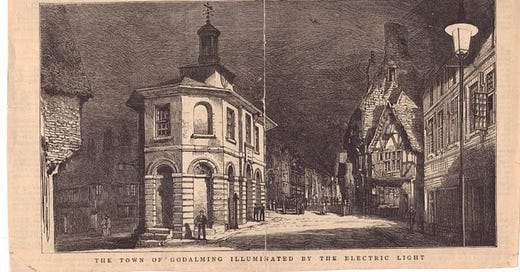



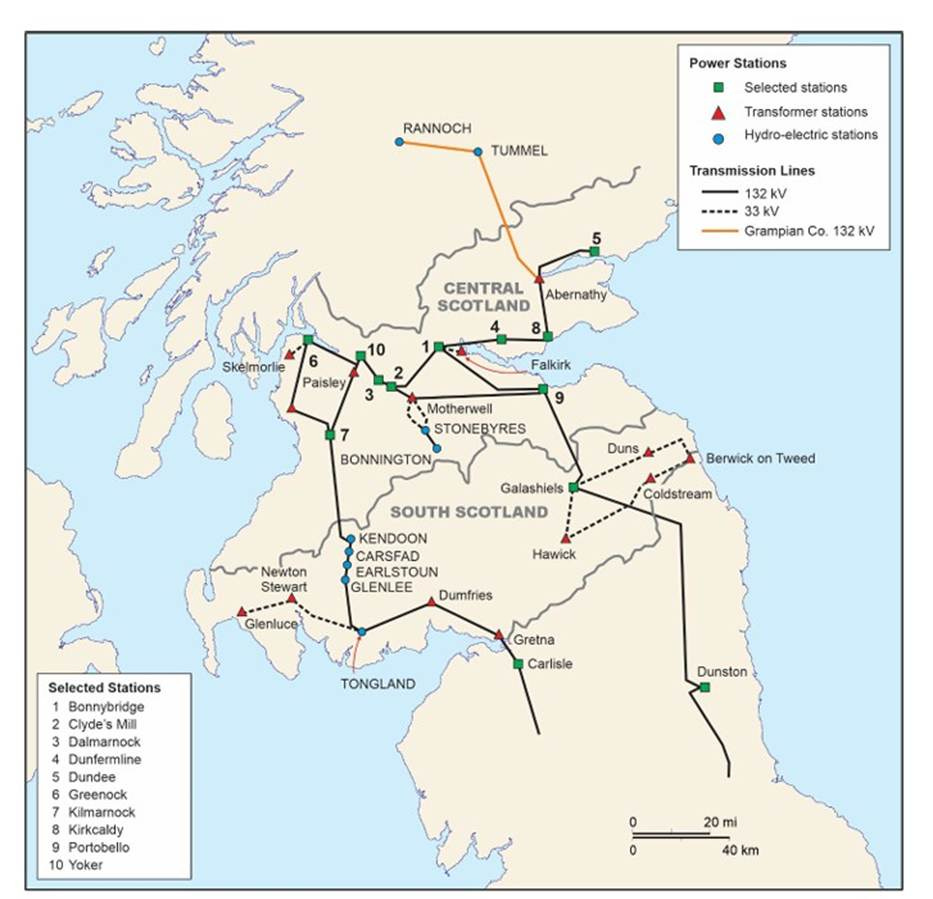
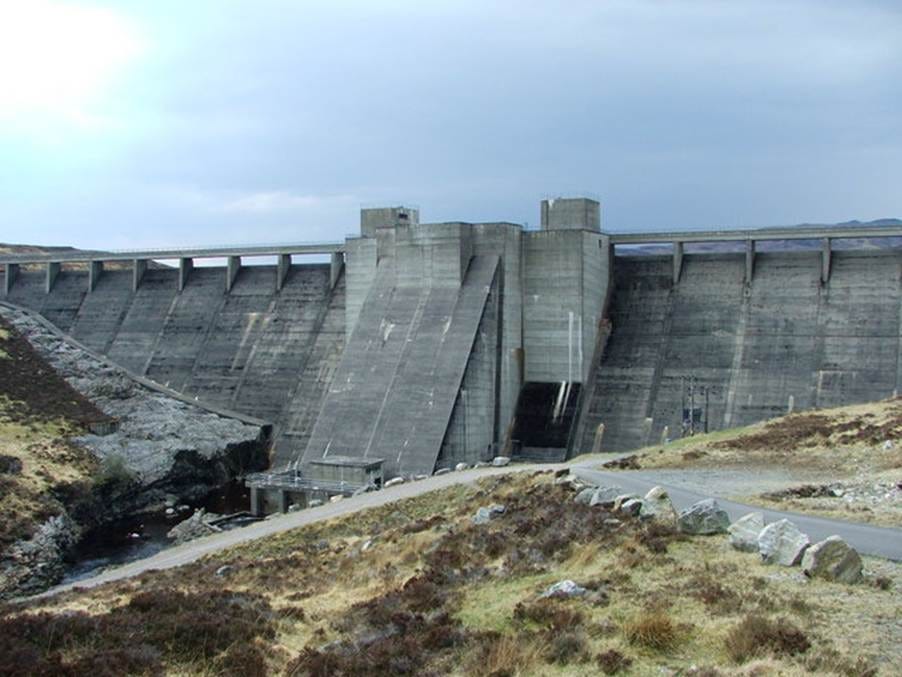

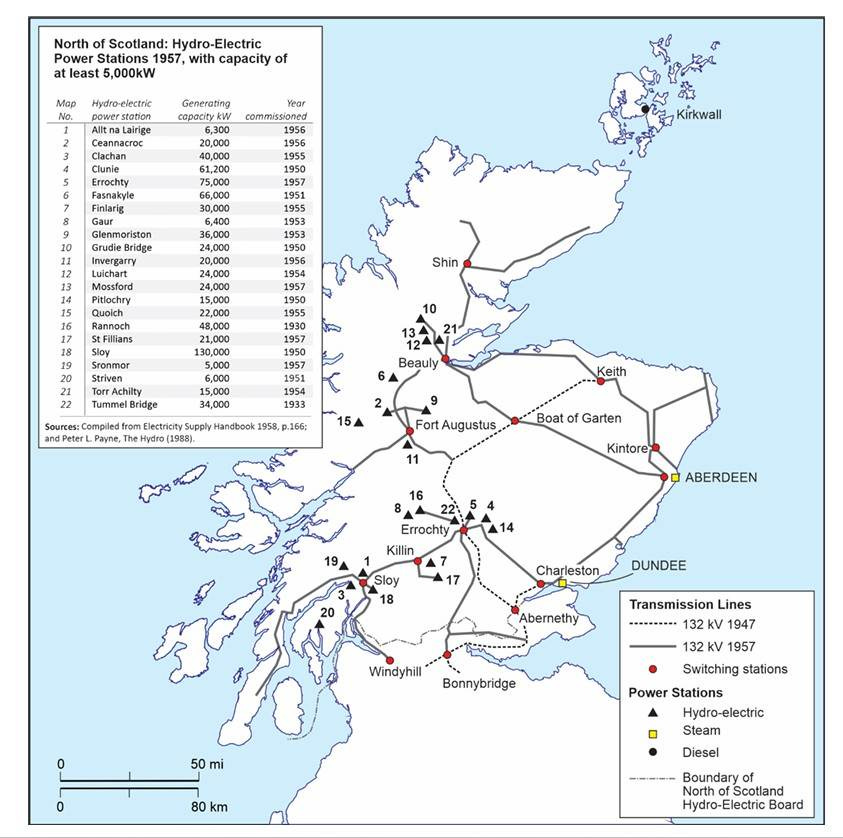
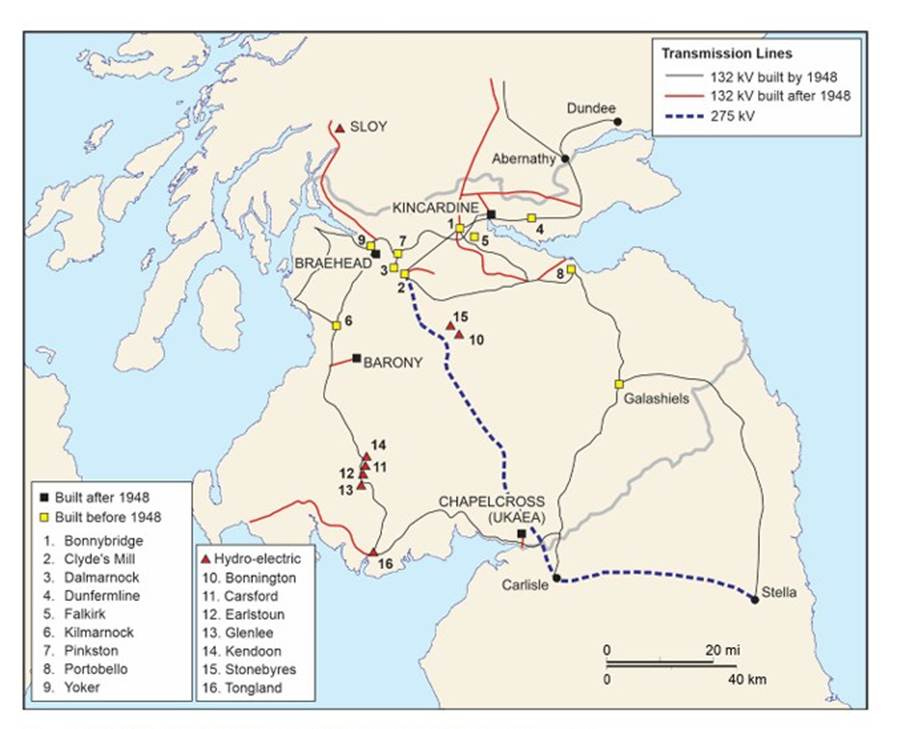
Love the blog Arthur! Having spent the last 20 years working on hydro and wind projects in Scotland it's fair to say my geographical reference points are more often substation and windfarm names than towns and cities :-)
It's instructive to see that 2013 ETYS Power Flow map bravely forecasting the East coast HVDC bootstrap being in operation by 2022 when it's now uncertain it may even be in service by 2029. I think someone should look at why NGESO's NOA process seems to have so comprehensively failed as a tool to justify *when* to spend on new transmission assets. It's theory at the time was rational; ie delay spending on new projects which are not needed immediately but it seems to have got lost in its attempt to be so rational and we now have ludicrous constraint costs. The rapid fall in the cost of renewables seems partly to be blame, with the NESO consistently underestimating how quickly more renewables (especially embedded, rooftop / behind the meter) would be added.